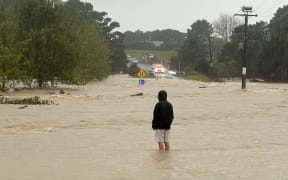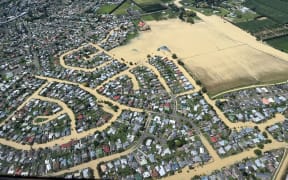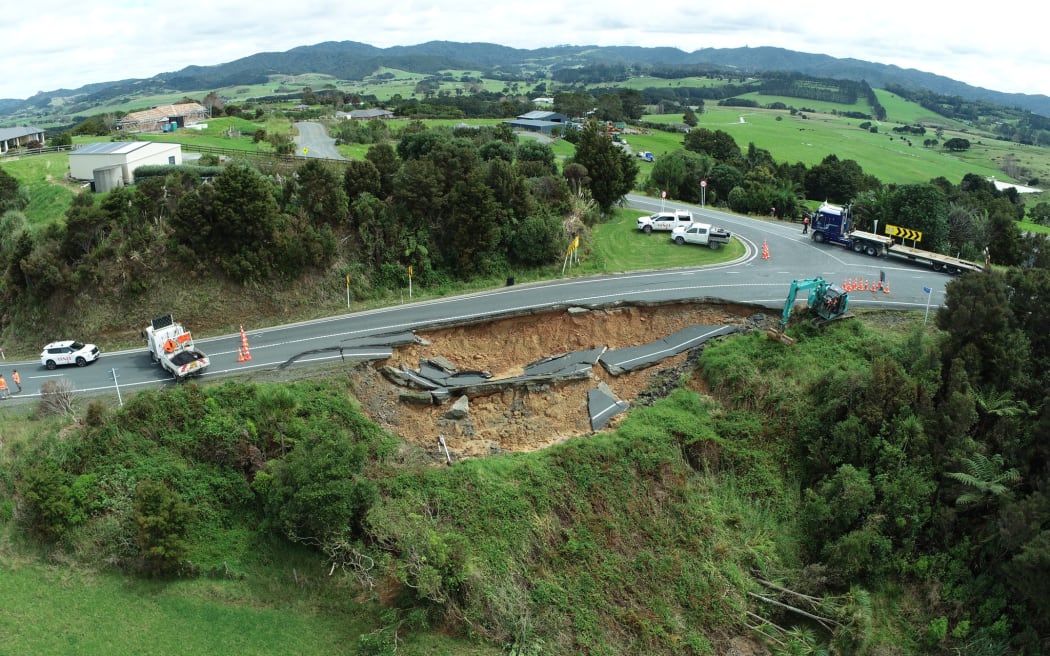
A slip on Kaiwaka-Mangawhai Rd near Hilltop Rd. Photo: Supplied / WSP
River levels are dropping in Hawke's Bay and an evacuation order for Esk Valley has been lifted, after the region received less rain than forecast overnight, while a route is now open between Auckland and Northland.
Gisborne, however, is now effectively cut off by road due to the closure of State Highway 2.
Overnight rain caused some flooding near Te Karaka and while the Waipaoa River is receding, mud and silt is covering the road in a number of places.
The road is closed between Matawai and Opotiki, which includes the Waioeka Gorge.
Traffic south of Gisborne can only get as far as Wairoa and the coastal route to East Cape is closed in a number of places due to slips and damaged bridges.
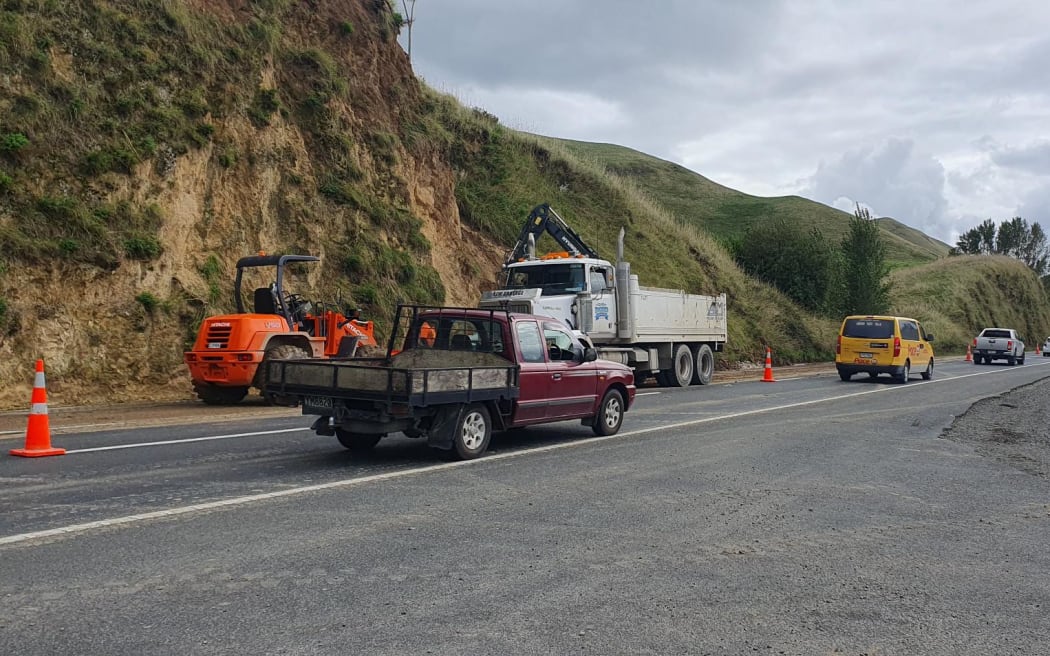
Roadworks at a slip on State Highway 2 just south of Havelock North, on Friday. Photo: RNZ / Phil Pennington
Hawke's Bay situation monitored closely
Hawke's Bay Civil Defence has lifted the evacuation order for the Esk Valley as of 2pm.
Group Controller Ian Macdonald said there is a risk of further rain today and rivers will continue to be monitored.
He says people should stay away from all rivers across Hawkes Bay and take extreme care when driving.
In a statement released early this afternoon, the Hawke's Bay Regional Council said work was now resuming to restore flood infrastructure.
Spokesperson Chris Dolley said small increases in the Ngaruroro and Tutaekuri rivers were not concerning and the council was continuing to monitor the Esk closely.
Dolley said the council wanted to assure the public that they continued to be on high alert to any changing weather conditions, and it was working hard to repair stop banks.
"Our focus areas for repairs are Brookfields in Awatoto, Taradale, Maraneui golf course, Omahu, Raupere in upper Fernhill, outer Pakowhai, Moteo, and Omaranui.
"Most rivers are levelling off, however we do issue caution for the Mangaone river and for those working in this area, as the river will likely continue to rise for a few more hours."
MetService has put a severe thunderstorm watch in place for the region until 5pm on Saturday.
Police said the number of people who remained uncontactable in Hawke's Bay and Tairāwhiti following Cyclone Gabrielle was 13 at 9pm on Friday - that is down from 23 people on Thursday evening.
"Getting in touch with those remaining 13 remains a priority for police and we are working as fast as we can," New Zealand police said in a statement early on Saturday.
Northern road opens up
Meanwhile, a route is now open between Auckland and Northland - after unprecedented rain in the area last night caused more flooding and slips.
The roads closed last night included much of State Highway 1 between Te Hana and Waipu.
The main highway remains closed between Brynderwyn and Waipu, but people can now travel between the regions via Dargaville. SH16 is also closed today between Kaukapakapa and Tauhoa due to slips.
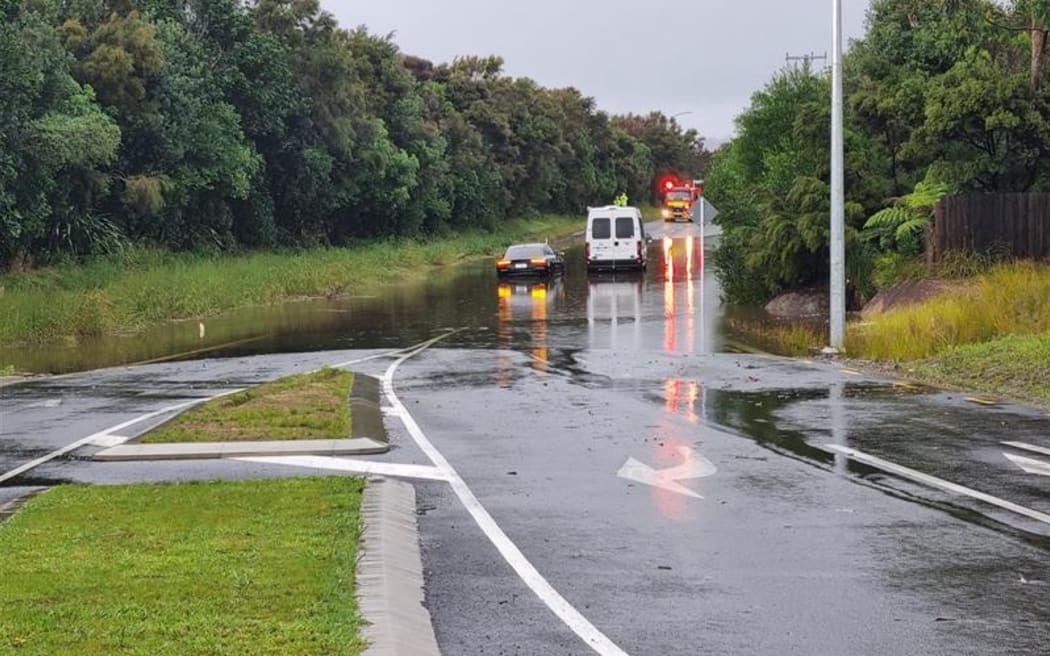
The scene of flooding in Mangawhai on Friday where a car got stuck after surface flooding. Photo: Samantha Olley
More than 200 people spent the night sheltering in camps in Mangawhai in Northland on Friday night as several slips blocked exit routes.
Overnight, Mangawhai residents who could not go back home stayed over at schools in the Kaipara District.
MetService said the Mangawhai area received 300mm of rain over a seven-hour period.
On Saturday morning, Fire and Emergency said it had responded to 112 weather-related calls since Friday evening, in Auckland and Northland.
Many of the callouts were to help people stranded due to slips and flooding on roads.
That included about 30 cars trapped on Friday night between slips on Tara Road in Mangawhai.
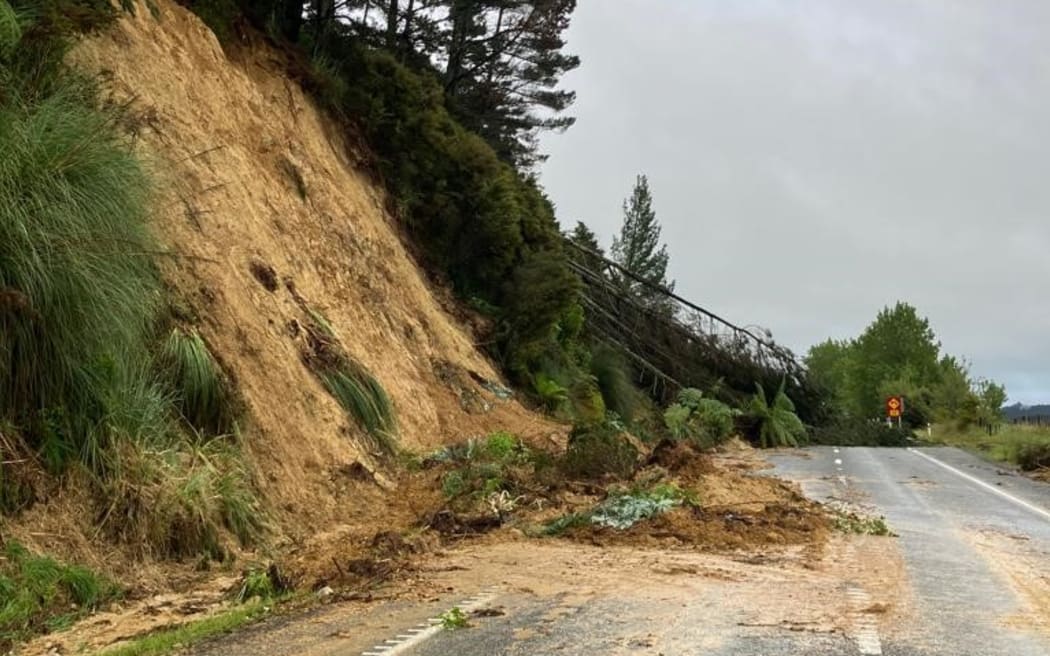
The main highway remains closed between Brynderwyn and Waipu. Photo: Supplied / Waka Kotahi
PM visits Muriwai
The prime minister has visited the flood-damaged Auckland suburb of Muriwai today, saying it has been an incredibly traumatic time for residents.
Chris Hipkins said being displaced from their homes, and not being able to return to collect their belongings, could put people under an enormous amount of pressure.
There would be a big price tag from the flooding, but the government was committed to working with communities to rebuild, Hipkins said.
He said that would involve making quick decisions about how - and where - to build.
A helicopter is delivering 200 litres of petrol to one of the cyclone-damaged communities on Auckland's west coast today.
Emergency Management is checking priority communities, including Karekare, Piha, Te Henga Bethells Beach and Muriwai, after last night's thunderstorms.
It says its isolated communities team is checking on residents based at the Waimaku War Memorial Hall.
A helicopter has also flown over Karekare and Lone Kauri Roads to check for damage.
A welfare drop-in is being planned for next week and trauma counselling will be provided.
In Piha, clean up work on Rayner Road is continuing and the Red Cross is at the surf club providing support.
Helicopters delivering aid in Tairāwhiti grounded
Tairāwhiti Civil Defence Emergency Management said the weather has grounded helicopter flights around the region that had been dropping off supplies to isolated families.
The flights would be back as soon as the weather cleared with the forecast looking good for Sunday, it said.
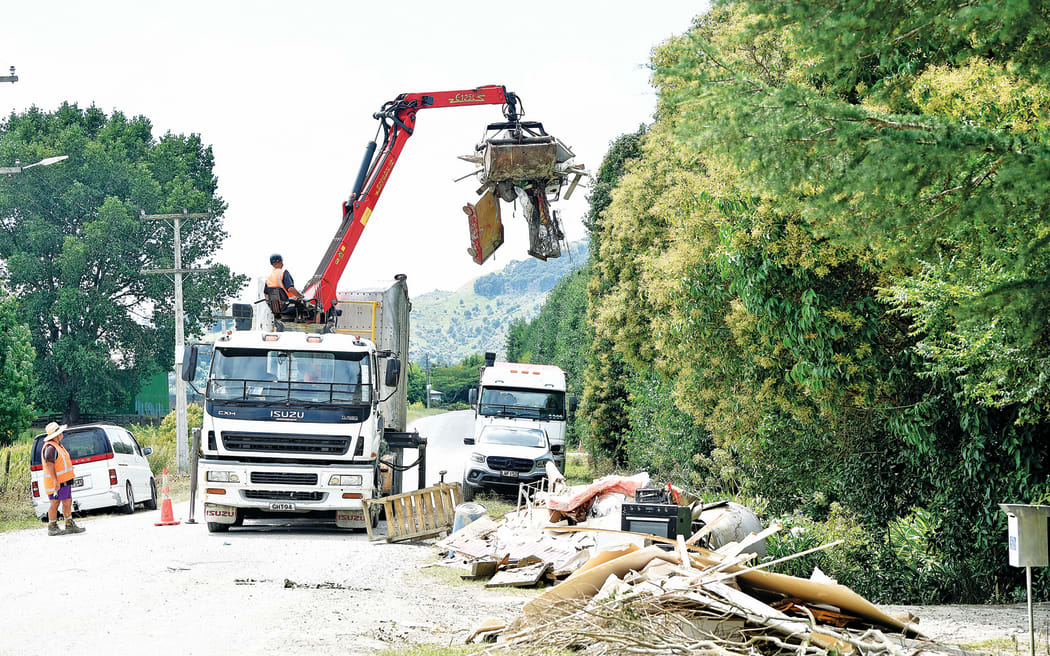
A truck removes belongings discarded on the roadside in Te Karaka this week. The small town of 500, about half an hour from Gisborne, was particularly hard hit by Cyclone Gabrielle. Photo: Rebecca Grunwell / Gisborne Herald
In Gisborne Mayor Rehette Stolz urged locals to seek help if they needed it this weekend, with the latest deluge likely causing more slips and flooding.
More atrocious weather had held back cyclone clean-up efforts and dampened people's spirits, she said.
It may mean more people would need support from council and Civil Defence, Stolz said.
"We might have missed people and we want to know if you need anything, so if you need to make contact with the Gisborne District Council Civil Defence please reach out, we are there to help you."
For the latest information on roading closures check the Waka Kotahi website.
Uawa Civil Defence in Tolaga Bay is urging people to stay off the roads since the Hikuwai river is currently at 11.5 metres. The Hikuwai has begun to drop as rain has stopped in the area. State Highway 35 is closed from Okitu to Uawa due to flooding at Rototahi, SH2 at Ormond is also closed.
Meanwhile, staff from the National Emergency Management Agency and council are still working out how to make a risky debris dam safer, so locals can return home.
Sixty-four homes were evacuated in Tokomaru Bay on Thursday due to fears a debris dam on the Mangahauini River would fail during more heavy rain.
Stoltz said the dam had held up so far, and staff were working at pace to come up with a solution.
New National Emergency Management Agency advice
- Heavy rain could cause further flooding, landslides, and damage to roads in regions impacted by Cyclone Gabrielle.
- Put safety first. Act quickly if you see rising water do not wait for official warnings. Head for higher ground and stay away from floodwater.
- Have grab bags ready with: medications, snacks, water, torches, pet food, and baby formula (if needed) in case you need to evacuate.
- Plan where you will go if you have to evacuate.
- Ensure that you have enough food, water, and other essential supplies to last for several days.
- Stay up to date with the latest information from MetService and your local Civil Defence Emergency Management Group.
- Wear protective clothing when cleaning flood water and mud including: mask, goggles, gloves, long pants, long-sleeved shirt, and gumboots or work shoes.

